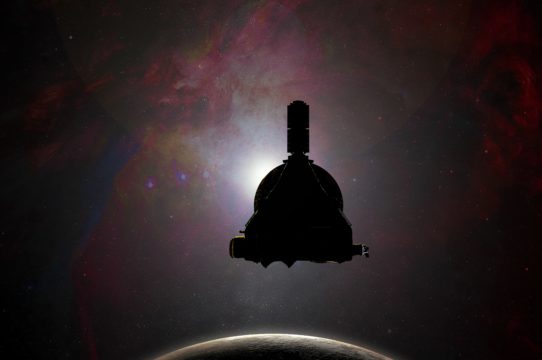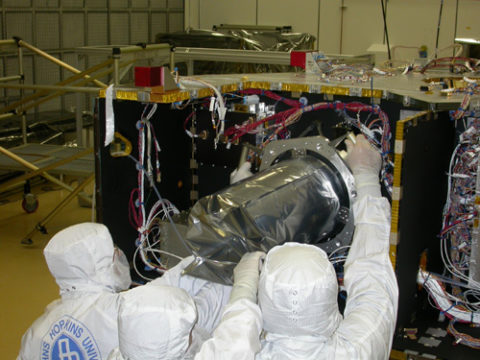The New Horizons team wants you to help measure the distance to the stars.
Do you have a light-bucket of a telescope and an imaging rig? Then NASA wants you to assist with a record-setting measurement.

NASA/Johns Hopkins University Applied Physics Laboratory/Southwest Research Institute/Steve Gribben/Alex Parker
This coming April, NASA will use the New Horizons spacecraft’s unique position nearly 47 astronomical units (a.u.) from the Sun to make the longest ever baseline parallax measurement.
Launched on January 19, 2006, it took New Horizons more than nine years to carry out its historic flyby of Pluto and Charon on July 14, 2015. Its primary mission completed, New Horizons then became the first mission to explore a Kuiper Belt Object of opportunity discovered in 2014 after its launch, passing 2,200 miles from 2014 MU69 Arrokoth on New Year’s Day, 2019. Now the spacecraft will be part of a project to measure something much farther away.
What is Parallax?
Parallax works by measuring the apparent position of an object on the sky from two separate locations, and noting the object's shift compared to more distant background sources. The longest traditional baseline available for Earth-based observers is 2 a.u. long: Observers look at a nearby star from one side of Earth’s orbit, and then look again from the other side six months later.
Despite what Han Solo said in the Star Wars spaceport cantina, a parsec is a measure of distance. One parsec, equivalent to 3.26 light-years, measures how close a star would have to be to show a 1-arcsecond shift on the sky over a one a.u. baseline.
No star lies close enough to the solar system to exhibit such a large shift in position — turns out that stars are so far away that their distance is difficult (thought not impossible) to measure from Earth. Astronomer Friedrich Bessel made the first successful parallax measurement in 1838, measuring a 314 milliarcsecond shift of 61 Cygni, placing it 10.4 light-years away (about one light-year shy of the currently accepted distance).
The Targets
The New Horizons team will now perform parallax experiments, using measurements from the spacecraft and from observers on Earth to estimate the distance of two nearby stars.
There's one target star for each hemisphere: Proxima Centauri in the Southern Hemisphere and Wolf 359 in the Northern Hemisphere. The 13.5-magnitude star Wolf 359 is located 7.9 light-years away in Leo, and lies along a relatively sparse region of sky near the ecliptic plane. The more familiar star Proxima Centauri is the closest star to our solar system at just 4.2 light-years. It lies along the star-dense galactic plane. Both stars are off at an angle from the outbound path of New Horizons, which is heading in direction of Sagittarius.

NASA
“The trajectory of New Horizons sets the parallaxes,” says Tod Lauer (National Optical Astronomy Observatory). “Stars along the trajectory, even if close, will have relatively small parallaxes. Stars perpendicular to it can get the full effect of the large baseline.”
The seasonal appearance of a target star as seen from the Earth in April also had to be considered. One candidate star, UV Ceti, which is best visible in northern fall was discarded for this reason.
The Long-Range Reconnaissance Imager (LORRI) survey camera will image the star fields for the two stars from New Horizons’ vantage point out in the Kuiper Belt. LORRI is very nearly the equivalent of a space-based, 8-inch aperture reflecting telescope.

NASA
Though the project won't result in any real scientific breakthrough, this experiment will demonstrate that such a long-baseline parallax measurement is possible. Also, unlike Earth-based measurements, which are taken six months apart, the Parallax Program’s measurement will be carried out simultaneously. This way, the tiny proper motions of the two target stars against the starry background will not matter.
The experiment will also demonstrate how spacecraft outbound from the solar system could use the shift of nearby stars to pinpoint their position in space.

William Keel/University of Alabama / SARA observatory
The key observations of the target stars will take place on April 22nd and April 23rd. The New Horizons Parallax Program gives full details for observers, including times and finder charts. The viewing times are optimized for North America (Wolf 359) and Australia and South America (Proxima Centauri).

William Keel/University of Alabama / SARA observatory
This isn’t the first time that amateur astronomers have supported the New Horizons team. In 2017, observing expeditions measured Arrokoth as it occulted a star. The data revealed the Kuiper Belt Object's two-lobed structure, which was confirmed during the 2019 flyby.
And New Horizons may just have enough fuel left over to explore one last object. “(The search for a third target) begins this summer, and will likely take 2-3 years,” says Alan Stern (NASA-Southwest Research Institute). “Arrokoth took four years to find.”
Be sure to take part in this historic observation, as New Horizons heads out of the solar system.
 5
5









Comments
Rod
February 29, 2020 at 1:22 pm
This looks like a fun project. New Horizons combined with Earth telescopes, the baseline is 47 AU for measuring the star parallax. Earth's orbital stellar parallax for stars like 61 Cygni uses 2 AU baseline. If this works we have 47/2 = 23.5x larger parallax sizes for various stars already measured from Earth. A star like 61 Cygni at 314 mas or 0.314" will be 7.379" parallax using the 47 AU baseline from New Horizons as an example. The larger baseline should make it easier to obtain stellar parallax values for the stars proposed in the investigation.
You must be logged in to post a comment.
Kevin-Walsh
March 3, 2020 at 7:04 pm
“Despite what Han Solo said in the Star Wars spaceport cantina, a parsec is a measure of distance.”
There was never a problem with Han Solo’s statement that The Millenium Falcon made the Kessel Run in under 12 parsecs. The speed of the ship allowed him to take a risky path along the minimum geodesic between two points - in under 12 parsecs. Slower ships would have been sucked into (say) a neutron star if they’d attempted that path - or they would stick to a conventional route that requires a longer geodesic.
It’s similar to taking the Straights of Magellan to get from the Atlantic to the Pacific, back in the days of sailing ships. The Straights required a (sailing) ship with an excellent ability to maneuver. Ships that can’t do that have to go the long way around.
You must be logged in to post a comment.
DrJ
April 20, 2020 at 2:23 pm
Perhaps I’m misreading your definition of parsec, but shouldn’t it read “...over a 1 a.u. baseline”, instead of “...over a 2 a.u. baseline”?
You must be logged in to post a comment.
David DickinsonPost Author
April 21, 2020 at 10:14 am
Yup, good catch, fixed. Though the span of Earth's orbit is two AU wide, the baseline for 1 parsec is indeed 1 AU.
You must be logged in to post a comment.
Alain Maury
April 20, 2020 at 3:11 pm
It seems pointless to do astrometry with small telescopes, when GAIA is providing 1000 times better measurements. I don't even know if NH is really good at measuring star positions, very likely not at the level provided by GAIA. Then maybe coupling both could improve upon GAIA alone, but other than that, it's like using a bicycle when you can use a jet.
You must be logged in to post a comment.
You must be logged in to post a comment.